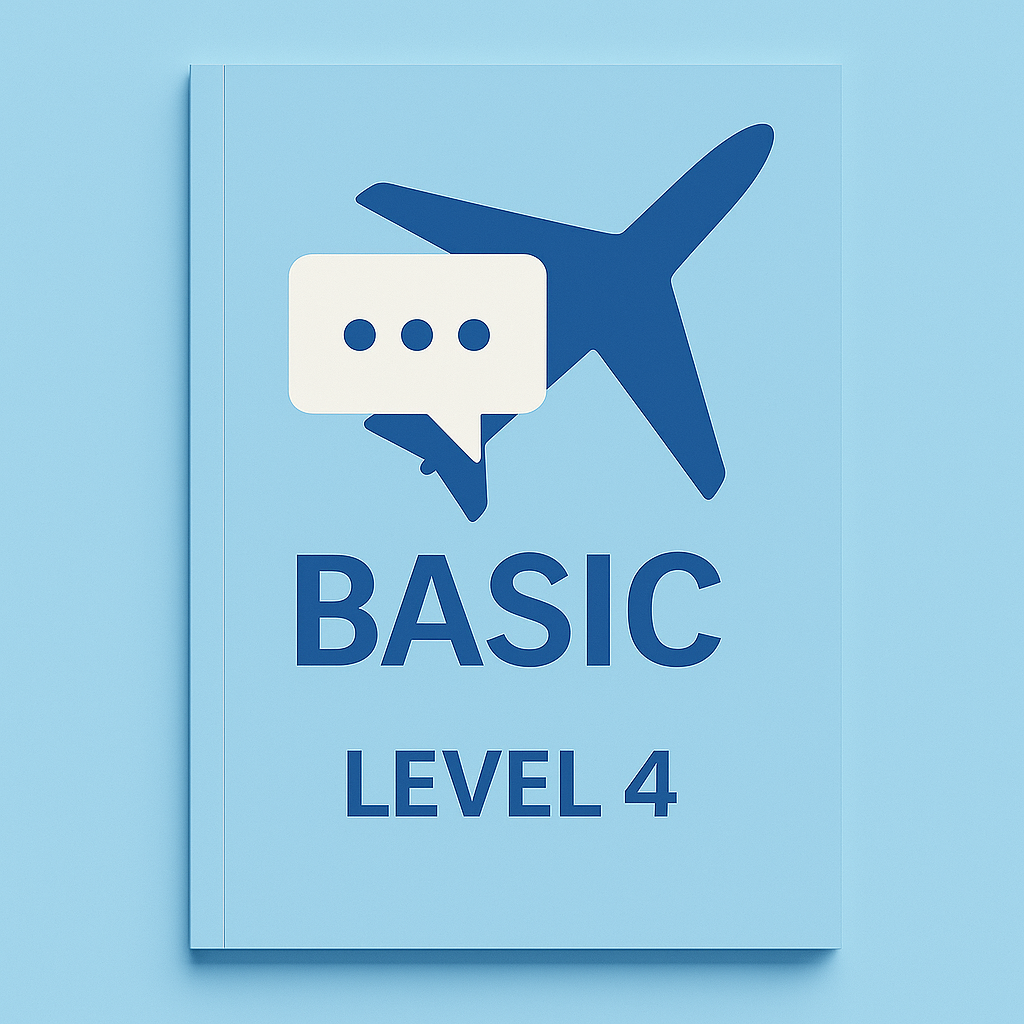ICAO English Rating Scale – ICAO Levels 4, 5, and 6 Explained
On this page, you’ll find a clear explanation of each ICAO level, including what examiners look for during your online ICAO Language Proficiency Test and how these standards are officially recognized under EASA and ICAO regulations. Based on this, you will know what to focus on during your ICAO English preparation — whether your goal is to achieve ICAO English Level 4 or to reach ICAO English Level 6 online.
The three recognized ICAO English proficiency levels are Operational (ICAO Level 4), Extended (ICAO Level 5), and Expert (ICAO Level 6).
Explanation of rating scale descriptors
Requirements for the respective ICAO level according to the Manual on the Implementation of ICAO Language Proficiency Requirements.
Pronunciation
General information
The six levels of pronunciation descriptors apply to both native and non-native speakers. A native speaker may be assessed at a low level if a regional dialect is so localized that it is not readily understood outside that region. Conversely, a non-native speaker may be assessed at ICAO Level 6 if their accent almost never interferes with ease of understanding.
Pre-operational (below Level 4)
Pronunciation, stress, rhythm and intonation are influenced by the first language or regional variation and frequently interfere with ease of understanding.
Accent at this Pre-operational Level 3 is so strong as to render comprehension by an international community of aeronautical radiotelephony users very difficult or impossible. It should be noted that native or second- language speakers may be assessed at this level in cases where a regional variety of the language has not been sufficiently attenuated.
ICAO Level 4: Operational
Pronunciation, stress, rhythm and intonation are influenced by the first language or regional variation, but only sometimes interfere with ease of understanding.
Operational Level 4 speakers demonstrate a marked accent, or localized regional variety of English. Occasionally, a proficient listener may have to pay close attention to understand or may have to clarify something from time to time. Operational ICAO Level 4 is certainly not a perfect level of proficiency; it is the minimum level of proficiency determined to be safe for air traffic control communications. While it is not an Expert level, it is important to keep in mind that pronunciation plays the critical role in aiding comprehension between two non-native speakers of English.
ICAO Level 5: Extended
Pronunciation, stress, rhythm and intonation, though influenced by the first language or regional variation, rarely interfere with ease of understanding.
Extended ICAO Level 5 speakers demonstrate a marked accent, or localized regional variety of English, but one which rarely interferes with how easily understood their speech is. They are always clear and understandable, although, only occasionally, a proficient listener may have to pay close attention.
ICAO Level 6: Expert
Pronunciation, stress, rhythm and intonation, though possibly influenced by the first language or regional variation, almost never interfere with ease of understanding.
An Expert ICAO Level 6 speaker may be a speaker of English as a first language with a widely understood dialect or may be a very proficient second-language speaker, again with a widely used or understood accent and/or dialect. The speakers’ accent or dialect may or may not identify them as second- language users, but the pronunciation patterns or any difficulties or “mistakes” almost never interfere with the ease with which they are understood. Expert speakers are always clear and understandable.
Structure
General information
Relevant grammatical structures and sentence patterns are determined by language functions appropriate to the task. Users may refer to the communicative aeronautical language functions, to the list of controller communicative tasks and to the classification of basic and complex structures in Appendix B for guidance. Language teaching specialists generally categorize grammatical errors into two classes: “global” and “local”. Global errors are those which interfere with meaning; local errors are those which do not interfere with meaning.
Pre-operational (below Level 4)
Basic grammatical structures and sentence patterns associated with predictable situations are not always well controlled. Errors frequently interfere with meaning.
A weak command of basic grammatical structures at this level will limit available range of expression or result in errors which could lead to misunderstandings.
ICAO Level 4: Operational
Basic grammatical structures and sentence patterns are used creatively and are usually well controlled. Errors may occur, particularly in unusual or unexpected circumstances, but rarely interfere with meaning.
Operational ICAO Level 4 speakers have good command of basic grammatical structures. They do not merely have a memorized set of words or phrases on which they rely but have sufficient command of basic grammar to create new meaning as appropriate. They demonstrate local errors and infrequent global errors and communication is effective overall. ICAO Level 4 speakers will not usually attempt complex structures, and when they do, quite a lot of errors would be expected resulting in less effective communication.
ICAO Level 5: Extended
Basic grammatical structures and sentence patterns are consistently well controlled. Complex structures are attempted but with errors which sometimes interferes with meaning.
Extended ICAO Level 5 speakers demonstrate greater control of complex grammatical structures than do Operational ICAO Level 4 speakers and may commit global errors from time to time when using complex structures. The critical difference between the ICAO Level 4 and ICAO Level 5 requirements concerns the use of basic grammatical structures and sentence patterns compared to the use of complex structures (see the glossary of basic and complex structures in Appendix B, Part IV). At ICAO Level 5, the structure descriptors refer to consistent control of basic structure, with errors possibly occurring when complex structures and language are used. There is actually a big jump between ICAO Level 4 and ICAO Level 5. ICAO Level 5 speakers will have a more sophisticated use of English overall, but will exhibit some errors in their use of complex language structures, but not in their basic structure patterns.
ICAO Level 6: Expert
Both basic and complex grammatical structures and sentence patterns are consistently well controlled.
Expert ICAO Level 6 speakers do not demonstrate consistent global structural or grammatical errors but may exhibit some local errors.
Vocabulary
General information
Vocabulary includes individual words and fixed expression. Vocabulary can be classified by the domains of meaning to which it refers. A partial list of vocabulary domains related to aviation communications is found in Appendix B of this manual. While memorizing phraseologies is neither an acceptable means of demonstrating language proficiency nor an effective or recommended language learning strategy, it is undeniable that context is a relevant factor in language proficiency. Therefore, learning or testing that focuses on, or is designed to elicit vocabulary related to, aeronautical radiotelephony communications is preferable.
Pre-operational (below Level 4)
Vocabulary range and accuracy are often sufficient to communicate on common, concrete or work-related topics, but range is limited and the word choice often inappropriate. Is often unable to paraphrase successfully when lacking vocabulary.
Gaps in vocabulary knowledge and/or choice of wrong or non-existent words are apparent at this level. This has a negative impact on fluency or results in errors which could lead to misunderstandings. The frequent inability to paraphrase unknown words or in the process of clarification makes accurate communication impossible.
ICAO Level 4: Operational
Vocabulary range and accuracy are usually sufficient to communicate effectively on common, concrete and work- related topics. Can often paraphrase successfully when lacking vocabulary in unusual or unexpected circumstances.
An Operational ICAO Level 4 speaker will likely not have a well-developed sensitivity to register (see glossary on page (ix)). A speaker at this level will usually be able to manage communication on work-related topics, but may sometimes need clarification. When faced with a communication breakdown, an Operational ICAO Level 4 speaker can paraphrase and negotiate meaning so that the message is understood. The ability to paraphrase includes appropriate choices of simple vocabulary and considerate use of speech rate and pronunciation.
ICAO Level 5: Extended
Vocabulary range and accuracy are sufficient to communicate effectively on common, concrete and work-related topics. Paraphrases consistently and successfully. Vocabulary is sometimes idiomatic.
Extended ICAO Level 5 speakers may display some sensitivity to register, with a lexical range which may not be sufficient to communicate effectively in as broad a range of topics as an ICAO Expert Level 6 speaker, but a speaker with Extended proficiency will have no trouble paraphrasing whenever necessary.
ICAO Level 6: Expert
Vocabulary range and accuracy are sufficient to communicate effectively on a wide variety of familiar and unfamiliar topics. Vocabulary is idiomatic, nuanced and sensitive to register.
ICAO Level 6 speakers demonstrate a strong sensitivity to register. Another marker of strong proficiency seems to be the acquisition of, and facility with, idiomatic expressions and the ability to communicate nuanced ideas. As such, use of idioms may be taken into account in assessment procedures designed to identify ICAO Level 6 users in a non-radiotelephony context. This is not however intended to imply that idiomatic usages are a desirable feature of aeronautical radiotelephony communications. On the contrary, use of idioms is an obstacle to intelligibility and mutual understanding between non-expert users and should therefore be avoided by all users in this environment.
Fluency
General information
For our purposes, fluency is intended to refer to the naturalness of the flow of speech production, the degree to which comprehension is hindered by any unnatural or unusual hesitancy, distracting starts and stops, distracting fillers (em … huh … er …) or inappropriate silence. Levels of fluency will be most apparent during longer utterances in an interaction. They will also be affected by the degree of expectedness of the preceding input which is dependent on familiarity with scripts or schemata described in Chapter 3.
Pre-operational (below Level 4)
Produces stretches of language, but phrasing and pausing are often inappropriate. Hesitations or slowness in language processing may prevent effective communication. Fillers are sometimes distracting.
The slowness of speech flow at this level is such that communication lacks concision and efficiency. Long silent pauses frequently interrupt the speech flow. Speakers at this level will fail to obtain the professional confidence of their interlocutors.
ICAO Level 4: Operational
Produces stretches of language at an appropriate tempo. There may be occasional loss of fluency on transition from rehearsed or formulaic speech to spontaneous interaction, but this does not prevent effective communication. Can make limited use of discourse markers or connectors. Fillers are not distracting.
Speech rate at this level may be slowed by the requirements of language processing, but remains fairly constant and does not negatively affect the speaker’s involvement in communication. The speaker has the possibility of speaking a little faster than the ICAO recommended rate of 100 words per minute if the situation requires (Annex 10, Volume II, 5.2.1.5.3 b)).
ICAO Level 5: Extended
Able to speak at length with relative ease on familiar topics but may not vary speech flow as a stylistic device. Can make use of appropriate discourse markers or connectors.
Rate of speech and organization of discourse at this level approach natural fluency. Under appropriate circumstances, rates significantly higher than the ICAO recommended rate of 100 words per minute can be achieved without negatively affecting intelligibility.
ICAO Level 6: Expert
Able to speak at length with a natural, effortless flow. Varies speech flow for stylistic effect, e.g. to emphasize a point. Uses appropriate discourse markers and connectors spontaneously.
Fluency at this level is native- like or near native-like. It is notably characterized by a high degree of flexibility in producing language and in adapting the speech rate to the context of communication and the purposes of the speaker.



